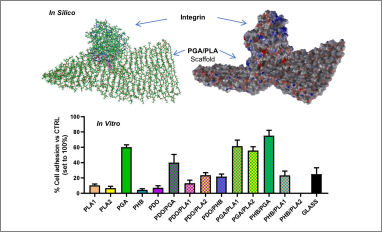 Congratulations to our Ph.D. students Simona Braccini and Gianni Pecorini for their scientific publication entitled “Adhesion of fibroblast cells on thin films representing surfaces of polymeric scaffolds of human urethra rationalized by molecular models of integrin binding: cell adhesion on polymeric scaffolds for regenerative medicine” in the journal “Journal of Biotechnology”.
Congratulations to our Ph.D. students Simona Braccini and Gianni Pecorini for their scientific publication entitled “Adhesion of fibroblast cells on thin films representing surfaces of polymeric scaffolds of human urethra rationalized by molecular models of integrin binding: cell adhesion on polymeric scaffolds for regenerative medicine” in the journal “Journal of Biotechnology”.
This work combines experimental and computational study of Balb/3T3 clone A31 mouse embryo fibroblasts cell line adhesion and proliferation on fourteen different polymeric surfaces prepared from poly(dioxanone) (PDO), poly(glycolic acid) (PGA), poly(hydroxybutyrate) (PHB), and poly(L-lactic acid) (PLA), and their 1:1 mixtures. The study was done with the aim to explore the attractive interactions between various synthetic biomaterials and simple model of the cell attachment mechanism involving the trans-membrane protein integrin. The considered polymeric biodegradable biomaterials can be used as scaffolds for tissue engineering and regenerative urology. During the growth of new tissue, the polymer scaffold is replaced by the extracellular matrix (ECM) synthetized by the proliferating cells. The adhesion and proliferation experiments were done on thin polymer films produced by solvent casting. The computational approach used 3D molecular models of two layers of ordered parallel polymeric fibres, which formed quasi-planar nanosized models of the scaffold surface. Experimental data showed that PGA based polymer films promote the cell adhesion. Cell proliferation testing, performed by incubating the fibroblast cells with the studied polymer films, disclosed that PLA, PHB/PLA and PHB/PGA systems are able to support proliferation of Balb/3T3 clone A31 cells equal to the plain glass. Relative interaction energies between 3D models of polymeric films and the α2 I domain of the cell adhesion receptor integrin α2β1 computed by molecular mechanics suggest that plain polymers PGA, PDO and mixtures PDO/PGA, PHB/PGA, and especially PGA/PLA display elevated affinity to the cell-attachment protein, which confirms the experimental observations. The combination of experimental and modelling approach can assist rational design of synthetic polymeric biomaterial for scaffolds of artificial human urethra that can be efficiently colonized by cells. Full paper available at https://doi.org/10.1016/j.jbiotec.2020.11.001


